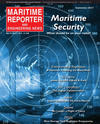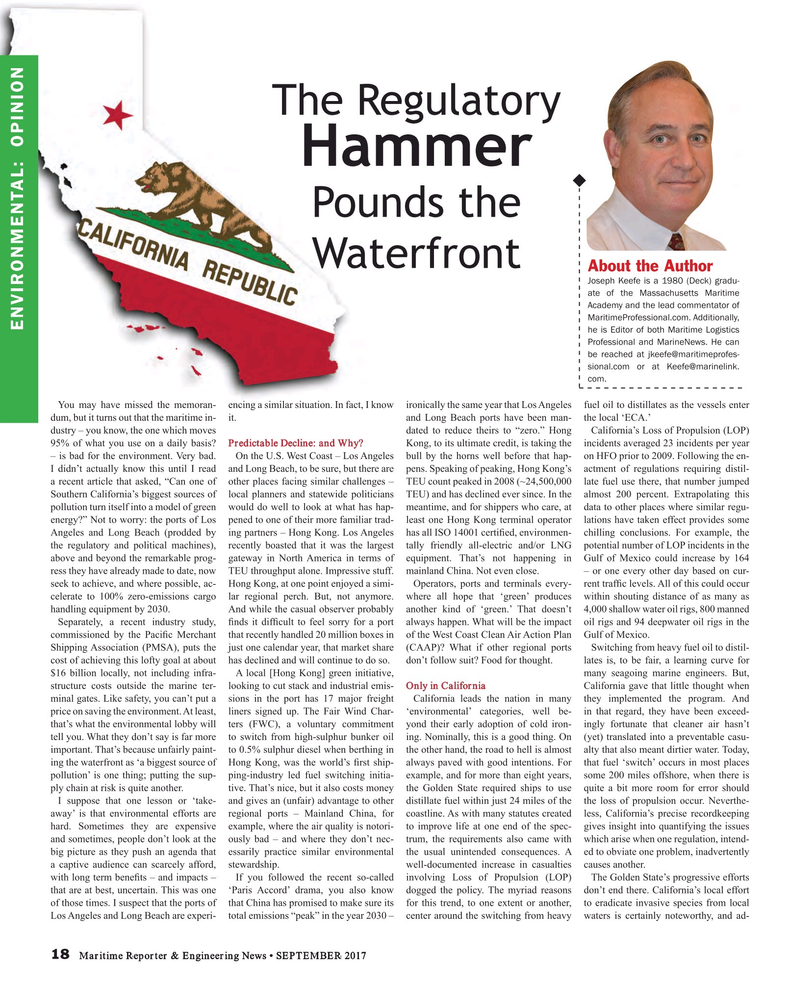
Page 18: of Maritime Reporter Magazine (September 2017)
U.S. Navy Quarterly
Read this page in Pdf, Flash or Html5 edition of September 2017 Maritime Reporter Magazine
The Regulatory
Hammer
Pounds the
Waterfront
About the Author
Joseph Keefe is a 1980 (Deck) gradu- ate of the Massachusetts Maritime
Academy and the lead commentator of
MaritimeProfessional.com. Additionally,
ENVIRONMENTAL: OPINION he is Editor of both Maritime Logistics
Professional and MarineNews. He can be reached at jkeefe@maritimeprofes- sional.com or at Keefe@marinelink.
com.
You may have missed the memoran- encing a similar situation. In fact, I know ironically the same year that Los Angeles fuel oil to distillates as the vessels enter dum, but it turns out that the maritime in- it. and Long Beach ports have been man- the local ‘ECA.’ dustry – you know, the one which moves dated to reduce theirs to “zero.” Hong California’s Loss of Propulsion (LOP) 95% of what you use on a daily basis? Predictable Decline: and Why? Kong, to its ultimate credit, is taking the incidents averaged 23 incidents per year – is bad for the environment. Very bad. On the U.S. West Coast – Los Angeles bull by the horns well before that hap- on HFO prior to 2009. Following the en-
I didn’t actually know this until I read and Long Beach, to be sure, but there are pens. Speaking of peaking, Hong Kong’s actment of regulations requiring distil- a recent article that asked, “Can one of other places facing similar challenges – TEU count peaked in 2008 (~24,500,000 late fuel use there, that number jumped
Southern California’s biggest sources of local planners and statewide politicians TEU) and has declined ever since. In the almost 200 percent. Extrapolating this pollution turn itself into a model of green would do well to look at what has hap- meantime, and for shippers who care, at data to other places where similar regu- energy?” Not to worry: the ports of Los pened to one of their more familiar trad- least one Hong Kong terminal operator lations have taken effect provides some
Angeles and Long Beach (prodded by ing partners – Hong Kong. Los Angeles has all ISO 14001 certi? ed, environmen- chilling conclusions. For example, the the regulatory and political machines), recently boasted that it was the largest tally friendly all-electric and/or LNG potential number of LOP incidents in the above and beyond the remarkable prog- gateway in North America in terms of equipment. That’s not happening in Gulf of Mexico could increase by 164 ress they have already made to date, now TEU throughput alone. Impressive stuff. mainland China. Not even close. – or one every other day based on cur- seek to achieve, and where possible, ac- Hong Kong, at one point enjoyed a simi- Operators, ports and terminals every- rent traf? c levels. All of this could occur celerate to 100% zero-emissions cargo lar regional perch. But, not anymore. where all hope that ‘green’ produces within shouting distance of as many as handling equipment by 2030. And while the casual observer probably another kind of ‘green.’ That doesn’t 4,000 shallow water oil rigs, 800 manned
Separately, a recent industry study, ? nds it dif? cult to feel sorry for a port always happen. What will be the impact oil rigs and 94 deepwater oil rigs in the commissioned by the Paci? c Merchant that recently handled 20 million boxes in of the West Coast Clean Air Action Plan Gulf of Mexico.
Shipping Association (PMSA), puts the just one calendar year, that market share (CAAP)? What if other regional ports Switching from heavy fuel oil to distil- cost of achieving this lofty goal at about has declined and will continue to do so. don’t follow suit? Food for thought. lates is, to be fair, a learning curve for $16 billion locally, not including infra- A local [Hong Kong] green initiative, many seagoing marine engineers. But, structure costs outside the marine ter- looking to cut stack and industrial emis- Only in California California gave that little thought when minal gates. Like safety, you can’t put a sions in the port has 17 major freight California leads the nation in many they implemented the program. And price on saving the environment. At least, liners signed up. The Fair Wind Char- ‘environmental’ categories, well be- in that regard, they have been exceed- that’s what the environmental lobby will ters (FWC), a voluntary commitment yond their early adoption of cold iron- ingly fortunate that cleaner air hasn’t tell you. What they don’t say is far more to switch from high-sulphur bunker oil ing. Nominally, this is a good thing. On (yet) translated into a preventable casu- important. That’s because unfairly paint- to 0.5% sulphur diesel when berthing in the other hand, the road to hell is almost alty that also meant dirtier water. Today, ing the waterfront as ‘a biggest source of Hong Kong, was the world’s ? rst ship- always paved with good intentions. For that fuel ‘switch’ occurs in most places pollution’ is one thing; putting the sup- ping-industry led fuel switching initia- example, and for more than eight years, some 200 miles offshore, when there is ply chain at risk is quite another. tive. That’s nice, but it also costs money the Golden State required ships to use quite a bit more room for error should
I suppose that one lesson or ‘take- and gives an (unfair) advantage to other distillate fuel within just 24 miles of the the loss of propulsion occur. Neverthe- away’ is that environmental efforts are regional ports – Mainland China, for coastline. As with many statutes created less, California’s precise recordkeeping hard. Sometimes they are expensive example, where the air quality is notori- to improve life at one end of the spec- gives insight into quantifying the issues and sometimes, people don’t look at the ously bad – and where they don’t nec- trum, the requirements also came with which arise when one regulation, intend- big picture as they push an agenda that essarily practice similar environmental the usual unintended consequences. A ed to obviate one problem, inadvertently a captive audience can scarcely afford, stewardship. well-documented increase in casualties causes another.
with long term bene? ts – and impacts – If you followed the recent so-called involving Loss of Propulsion (LOP) The Golden State’s progressive efforts that are at best, uncertain. This was one ‘Paris Accord’ drama, you also know dogged the policy. The myriad reasons don’t end there. California’s local effort of those times. I suspect that the ports of that China has promised to make sure its for this trend, to one extent or another, to eradicate invasive species from local
Los Angeles and Long Beach are experi- total emissions “peak” in the year 2030 – center around the switching from heavy waters is certainly noteworthy, and ad- 18 Maritime Reporter & Engineering News • SEPTEMBER 2017
MR #9 (18-25).indd 18 MR #9 (18-25).indd 18 9/6/2017 10:13:53 AM9/6/2017 10:13:53 AM

 17
17

 19
19
